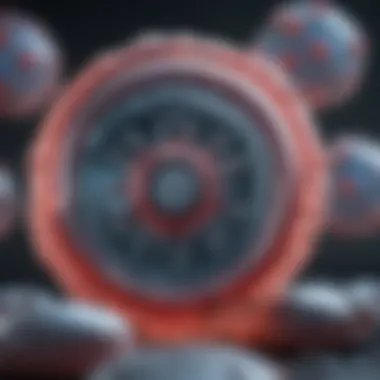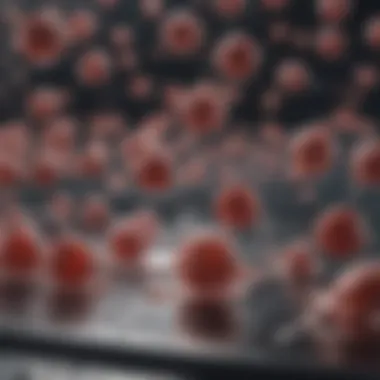Interferin Transfection Reagent: Mechanisms and Applications


Intro
Interferin transfection reagents have garnered significant attention in the field of molecular biology. Their unique properties and effectiveness in delivering genetic material into cells make them indispensable tools in both research and therapeutic applications. Understanding the mechanisms of these reagents allows scientists and researchers to exploit them for various biotechnological advancements.
As the world of molecular biology advances, the demand for superior transfection methods increases. Traditional alternatives often fall short in efficiency and specificity. Interferin reagents address these shortcomings, offering a more reliable option for gene delivery. This article aims to dissect the relevance of interferin transfection reagents through their applications, mechanisms of action, and future prospects.
We will explore how these reagents enhance gene delivery in various cell types, the potential they hold for advancing gene therapy, and how they can facilitate groundbreaking research. Critical evaluation of recent studies will provide insights into their comparative efficacy, leading to a deeper understanding of their role in modern molecular biology.
Prelims to Interferin Transfection Reagent
The significance of interferin transfection reagents in molecular biology cannot be overstated. These reagents play a critical role in advancing our understanding of genetic manipulation and its applications in therapeutic research. Interferin transfection reagents facilitate the delivery of nucleic acids into cells, which is a fundamental process in research and clinical settings. Their effectiveness directly impacts the success of gene delivery systems.
In the landscape of transfection technology, interferin stands out for its unique properties that address various challenges faced by researchers. Traditional methods often fall short in specificity and efficiency. Interferin offers improved performance, which is particularly important for sensitive experiments and high-stakes applications. This section will explore the definition and purpose of interferin transfection reagents, followed by a brief overview of their historical context in the evolving field of molecular biology.
Definition and Purpose
Interferin transfection reagents are specialized solutions designed to enhance the uptake of genetic material, such as DNA and RNA, into target cells. The primary purpose of these reagents is to facilitate efficient transfection, which is essential for a variety of applications including gene expression studies, gene editing, and the development of therapeutic strategies.
Transfection efficiency is affected by several factors, including the type of cell being targeted and the nature of the genetic material to be delivered. Interferin reagents are formulated to optimize these parameters, providing researchers with tools for effective gene manipulation. By enabling higher transfection rates, interferin also supports robust experimental results, thus advancing scientific inquiry.
Historical Context
The evolution of interferin transfection reagents can be traced back to the need for better tools in molecular biology. Early methods of transfection relied on physical and chemical techniques that often resulted in low efficiency and cell toxicity. Over the years, a variety of approaches were developed, including lipofection and electroporation. However, the demand for a more gentle and effective transfection method led to the introduction of interferin.
Interferin reagents emerged as alternatives in the late 20th century, displaying improved efficiency without the common drawbacks associated with earlier methods. As molecular biology advanced, so did these reagents. They have been refined to target specific cell types and various forms of nucleic acids. This historical development reflects the continuous effort to enhance tools available for genetic research and applications.
Mechanism of Action
Understanding the mechanism of action of interferin transfection reagent is essential for optimizing its use in various applications, from gene therapy to cellular studies. This section delves into how interferin operates at a molecular level, outlining its critical processes and implications for successful transfection. The intricacies of cellular uptake, intracellular pathways, and gene expression outcomes are fundamental to maximizing the potential of this reagent. By examining these elements, researchers can harness the full capabilities of interferin and improve the efficacy of their experiments.
Cellular Uptake Process
The cellular uptake process of interferin transfection reagent is a pivotal first step in effective gene delivery. Interferin primarily relies on endocytosis to penetrate the cell membrane. Once introduced to the extracellular environment, the reagent binds to the target cell surface. This binding triggers the cell to engulf the reagent along with the nucleic acids to be delivered. Notably, the efficiency of this process can vary significantly depending on cell type and culture conditions.
While many transfection reagents exhibit toxicity, interferin is designed to minimize cytotoxicity during this uptake phase. Thus, it is crucial to optimize factors such as reagent concentration, incubation time, and temperature to enhance the uptake rate without inducing cell death. By understanding these parameters, researchers can alter their protocols for greater success with different cell lines.
Intracellular Pathway
Once inside the cell, the interferin reagent follows a specific intracellular pathway that facilitates the release of the nucleic acids into the cytoplasm. This process is often facilitated by endosomal escape, where the complex containing the nucleic acid is liberated from the endosomes. The efficiency of this step directly influences the ultimate success of transfection. Studies indicate that interferin utilizes pH-sensitive mechanisms to disrupt the endosomal membrane, allowing for a more effective release of genetic material.
In this stage, the stability of the delivered constructs can be a significant concern. It is important to ensure that the nucleic acids remain intact while navigating through the complex intracellular environment. Researchers must also consider how various cellular conditions, such as metabolic activity and stress responses, can impact the efficacy of intracellular transport and subsequent gene delivery.
Gene Expression Outcomes
The end goal of using interferin transfection reagent revolves around achieving desired gene expression outcomes. It is during this final stage that the real impact of transfection becomes evident. Once the nucleic acids reach the cytoplasm, they can be translated into functional proteins, influencing various biological processes.
The efficacy of gene expression is influenced by numerous factors, including:


- The quality and type of nucleic acid used (e.g., plasmid DNA, RNA).
- The duration of transfection and the stability of the transfected materials.
- The inherent characteristics of the host cell, which can lead to varied gene expression levels.
Achieving optimal gene expression is not simply a matter of delivering nucleic acids. It often requires fine-tuning various parameters to align with the specific requirements of the target cells. Understanding these conditions can lead researchers to explore innovations in gene delivery systems, extending the current capabilities of interferin as a transfection reagent.
"Effective transfection is not only about cell entry but also ensuring the subsequent processing of nucleic acids leads to desirable biological outcomes."
Comparative Analysis with Other Transfection Reagents
In the field of molecular biology, understanding transfection methods is crucial. Different transfection reagents, including interferin, have varying efficiencies, mechanisms, and applications. This section discusses how interferin transfection reagents stack up against traditional techniques like lipofection, electroporation, and nucleofection. By scrutinizing their unique characteristics, benefits, and limitations, researchers can make informed decisions on which method best suits their experimental needs.
Lipofection
Lipofection is a widely used method for introducing nucleic acids into cells. This technique employs liposomes—tiny lipid-based vesicles that encapsulate the genetic material. The process is generally straightforward, needing minimal optimization and providing decent transfection rates in many cell types. Specifically, lipofection has shown remarkable effectiveness with adherent cells, primarily due to its ease of use and scalability. However, its efficiency can be variable, depending on the cell type. Furthermore, it may introduce toxicity at high dosages, which is a consideration for long-term studies.
One of the key comparisons with interferin reagents is delivery efficiency. Lipofection often results in lower transfection rates in certain primary cells compared to interferin. This discrepancy can affect experimental outcomes, especially in sensitive applications like gene therapy. Consequently, while lipofection remains a popular choice, researchers must weigh its efficiency against potential toxicity and the specific needs of their experiments.
Electroporation
Electroporation is another alternative for transfecting cells. This method applies an electric field to cells, creating temporary pores in their membranes. Interestingly, it is capable of delivering larger DNA molecules compared to lipofection. The advantages of electroporation include its broad applicability across various cell types, including hard-to-transfect primary cells and even certain tissues in vivo.
However, electroporation does come with challenges. The technique requires specialized equipment and can lead to cell damage, particularly when compared to gentler methods like interferin transfection. Furthermore, the optimization of voltage and pulse duration necessitates a learning curve, often unique to individual cell types. Thus, while electroporation offers significant advantages in specific contexts, its practical limitations can deter its routine use in some laboratories.
Nucleofection
Nucleofection represents a sophisticated and highly efficient transfection method, especially for hard-to-transfect cells. This strategy employs an electric field, similar to electroporation, but offers greater control over the process. As a result, nucleofection provides higher transfection efficiencies, often surpassing both lipofection and electroporation, particularly in primary and stem cells.
The drawback, however, is linked to its operational complexity and cost. Nucleofection generally requires specialized reagents and equipment, which may not be accessible to every lab. Also, the need for refinement during protocol establishment may induce variability among different experiments. In contrast, interferin transfection reagents offer a more user-friendly approach with competitive efficiency, making them a favorable choice for many laboratories.
In summary, each transfection method has its specific advantages and potential drawbacks. When comparing interferin reagents to lipofection, electroporation, and nucleofection, one should consider both efficiency and practicality in relation to target cell type and experimental goals. Understanding these distinctions is vital for optimizing gene delivery strategies and achieving desired research outcomes.
Applications in Research
The applications of interferin transfection reagents in research highlight their significance in advancements within molecular biology and therapeutics. Over the years, the demand for reliable transfection methods has surged due to the increased focus on gene delivery, vaccine development, and creating new cell lines. Each of these applications benefits from the unique properties of interferin reagents, making them an invaluable tool in the scientific process.
Gene Therapy
Gene therapy has emerged as a groundbreaking approach to treating genetic disorders by directly targeting the underlying cause of such diseases. Interferin transfection reagents have shown notable efficiency in delivering therapeutic genes into cells. This efficiency is critical, as it maximizes gene expression levels while minimizing off-target effects. Researchers have found that these reagents can ensure stable gene integration and expression, which is vital for the sustained therapeutic effect.
"Gene therapy represents a paradigm shift in how we approach treatment for genetic conditions. Leveraging advanced transfection techniques is paramount for success."
The adaptability of interferin reagents across various cell types enhances their utility in clinical applications. For instance, in hemophilia studies, interferin allows precise delivery of factor genes, contributing to successful therapeutic outcomes. The ongoing developments in this field underscore the potential of interferin for future breakthroughs in genetic medicine.
Vaccine Development
Vaccine development has progressed significantly with the introduction of innovative transfection technologies. Interferin transfection reagents facilitate the delivery of antigen-encoding plasmids into cells, driving an immune response. This capability has applications in both preventative vaccinations and therapeutic vaccines against diseases like cancer.
In particular, the ability of these reagents to induce robust immune responses is key to their application. For instance, in designing mRNA vaccines, which have gained notoriety in recent years, interferin reagents contribute to optimizing the delivery system. By ensuring high levels of mRNA expression, they drastically enhance the production of antigens, thus strengthening vaccine efficacy.


Lastly, due to rising global health concerns, rapid vaccine development is essential. Interferin reagents grant researchers a streamlined method to achieve their developmental goals without compromising safety or efficacy, marking a significant step forward in public health initiatives.
Cell Line Development
The creation of stable cell lines is pivotal for various research fields, including drug discovery and basic biological research. Interferin transfection reagents provide a reliable method for generating cell lines that express recombinant proteins or specific traits. This capability supports consistent experimental conditions, which are necessary for reproducibility and validation in scientific experiments.
The process of establishing stable cell lines often requires precise selection of integration vectors and high transfection efficiency to achieve successful outcomes. Many researchers have noted that interferin reagents optimize these parameters, rendering them preferable to traditional methods.
Moreover, customization options offered by interferin reagents allow researchers to refine their techniques, accommodating specific needs unique to their experiments. Overall, the application of these reagents in cell line development underscores their importance in ensuring that biological studies progress efficiently and effectively.
Optimization Techniques
The discussion of optimization techniques is crucial in the realm of interferin transfection reagents. These techniques aim to enhance transfection efficiency while minimizing potential risks. It is essential to narrow down several specific elements that contribute to effective optimization, like reagent concentration, cell type variability, and co-transfection strategies. Understanding these factors can lead to better experimental outcomes, thus improving research advancements in molecular biology.
Reagent Concentration
Finding the correct reagent concentration is vital for successful transfection. Using too little may result in inefficient gene uptake, while too much can cause cell toxicity.
- Generally, even slight variations in concentration can influence the overall results.
- Researchers often conduct titration experiments to determine the optimal levels.
- Balance between efficacy and safety should be a priority.
To summarize, optimizing concentration is not just a technicality; it can significantly influence the success of transfection experiments. Proper evaluation can yield reliable gene expression, ensuring reproducibility.
Cell Type Variability
Cell type variability plays an important role in optimizing transfection methods. Different cells exhibit unique characteristics that can affect their uptake abilities.
- For instance, adherent cells like HEK293 may respond differently to transfection compared to suspension cells such as lymphocytes.
- It is necessary to recognize these distinctions and adjust protocols according to the specific requirements of each cell line.
- Moreover, certain cells may require additional components to facilitate better uptake, influencing the choice of reagents.
Co-Transfection Strategies
Co-transfection strategies involve the simultaneous introduction of multiple nucleic acids into target cells. This method can enhance the outcomes of gene expression by allowing researchers to explore more complex interactions between different genes.
- Advantages of co-transfection include:
- However, it is also essential to consider potential interactions between the introduced plasmids, which can lead to unpredicted challenges.
- Increased expression levels of proteins due to the addition of helper plasmids.
- The ability to study regulatory relationships between genes.
Overall, employing co-transfection strategies can further elevate productivity within transfection experiments, provided that researchers remain vigilant about potential complications.
Challenges and Limitations
Understanding the challenges and limitations of interferin transfection reagents is crucial in maximizing their potential within molecular biology. Addressing these issues ensures that researchers can enhance the efficiency of transfection while minimizing any negative impact on cells. Each of the discussed limitations plays a significant role in determining how these reagents can be applied in scientific research and therapeutic applications.
Toxicity Concerns
One of the primary challenges associated with interferin transfection reagents is toxicity. High levels of toxicity can compromise cellular viability, impacting the overall success of transfection experiments. The cellular response to these reagents typically relates to dosage and exposure time. Researchers have identified that while optimal reagent concentrations can facilitate efficient gene delivery, excessive amounts can result in adverse outcomes like cell death or altered gene expression.
In some scenarios, toxicity also appears to have a variable nature depending on cell type. This variability creates a need for careful optimization for each specific application. It is important for researchers to closely monitor cellular responses and conduct viability assays to assess the extent of toxicity. Moreover, ongoing investigations are focusing on developing formulations that mitigate this issue. Using lower concentrations or incorporating protective agents may help reduce toxicity while maintaining effective transfection rates.


Delivery Efficiency Limitations
Another critical limitation is the delivery efficiency of interferin reagents. While these reagents show promise, they may not always achieve the desired level of gene expression due to varying factors. Cell type, culture conditions, and the specific nature of nucleic acids used for transfection can all influence effectiveness. For instance, some cell lines may exhibit inherently lower uptake capabilities regardless of the quality of the transfection reagent.
Furthermore, competition with cellular mechanisms plays a role in how well transfection occurs. Cells possess various natural barriers that can hinder the efficient uptake and subsequent expression of genetic material. This situation emphasizes the necessity of understanding and overcoming these barriers through advanced techniques or combined strategies. Implementing co-transfection may enhance overall delivery effectiveness by using a mixture of reagents. Such approaches warrant thorough exploration to harness their maximum potential for successful gene delivery.
Regulatory Hurdles
Navigating regulatory hurdles presents another layer of complexity for researchers using interferin transfection reagents. The safety and efficacy of any transfection reagent must comply with stringent regulations put forth by governing health organizations. This regulatory framework raises significant barriers, especially when transfection technologies approach clinical applications.
Researchers may be required to conduct extensive testing to demonstrate the safety profile of these reagents before approval. The process can extend timelines and demand substantial resources. Additionally, there is a growing emphasis on transparency concerning the quality control processes involved in reagent manufacture. These regulations aim to ensure that innovative breakthroughs using interferin reagents can transition smoothly from research to practical applications in gene therapy or vaccine development.
As the landscape of genetic research continues to expand, addressing these challenges will be key to leveraging the full potential of interferin transfection reagents across various applications. Understanding toxicity, delivery efficiency, and regulatory frameworks allows for informed decision-making and better experimental outcomes.
Future Directions in Transfection Technology
The field of transfection technology is evolving rapidly. As researchers strive to tackle more complex challenges in gene therapy, the exploration of future directions becomes crucial. Innovations in transfection reagents like Interferin are shaping the practices laboratory techniques. By enhancing efficacy and safety, they facilitate more precise applications in various biotechnological endeavors.
Innovations in Formulation
Innovative formulations for transfection reagents are essential for improving delivery mechanisms. This includes the development of nanoparticles and liposomes which offer enhanced stability and cellular uptake. New formulations are often designed to reduce toxicity while increasing efficiency. For example, the use of biodegradable materials in formulations can minimize adverse effects on cells. Adapting these innovations not only increases the transfection rates but also supports safer applications in sensitive experiments, such as those involving primary cells or stem cells.
In recent studies, adaptive delivery systems have emerged. These systems are able to respond to the cellular environment. Such responsiveness allows for tailored transfection strategies that can be executed during active cellular processes, significantly increasing the precision of gene delivery.
Integration with New Technologies
The integration of emerging technologies into transfection practices presents significant opportunities for advancement. For instance, CRISPR-Cas9 gene editing technology can be combined with Interferin transfection reagents to enhance gene delivery efficiency. By utilizing the strengths of both systems, researchers can achieve targeted modifications with high accuracy.
Moreover, combining transfection techniques with artificial intelligence may optimize protocol development. AI algorithms can analyze vast amounts of data to predict the success of transfection under various conditions, thus streamlining experiments. This integration will likely lead to reduced trial-and-error phases in research.
Focus on Personalized Medicine
Personalized medicine requires innovative approaches to gene delivery. The shift towards tailoring treatments to individual needs highlights the importance of transfection technology. Interferin reagents could play a crucial role in this transition by allowing specific targeting of therapies.
For instance, personalized cancer treatment may utilize Interferin to deliver designed RNA molecules or gene constructs based on an individual's genetic makeup. Such targeted treaments can maximize therapeutic outcomes while minimizing side effects. This focus on individual variations in treatment regimens is integral to the future of medicine, as it aligns well with the broader goals of precision health.
Effective transfection technology, especially innovations made through Interferin, will pivot the future landscape of personalized medicine.
Culmination
The conclusion serves as a vital component of this article, synthesizing the critical aspects discussed throughout the text regarding interferin transfection reagents. These reagents stand out as significant tools in molecular biology, particularly due to their efficiency in gene delivery and application across various fields, from gene therapy to vaccine development.
The key points explored provide a rich understanding of how interferin works and why it is preferred in certain situations over traditional methods. Having a heightened awareness of the mechanisms of action, applications, and limitations enhances the ability of researchers to select the appropriate transfection method.
Summary of Key Points
- Interferin transfection reagent offers a more effective solution for gene delivery compared to traditional methods.
- Understanding its mechanism of action helps in optimizing its use in research and clinical applications.
- The growing applications in gene therapy, vaccine development, and cell line creation highlight its versatility and importance in modern science.
Implications for Future Research
The future of research using interferin transfection reagents appears promising as advancements continue to unfold. Several implications are expected:
- Further Innovations: Ongoing research may lead to improved formulations that enhance transfection efficiency and reduce toxicity.
- Enhanced Delivery Systems: The integration of new delivery technologies can facilitate better outcomes in gene therapy.
- Personalized Approaches: A focus on personalized medicine will require tailored transfection strategies that can effectively match patient-specific needs and genetic backgrounds.
In summary, continued exploration of interferin's capabilities and limitations will guide the future trajectory of transfection technology, fostering substantial growth in research and therapeutic applications.







